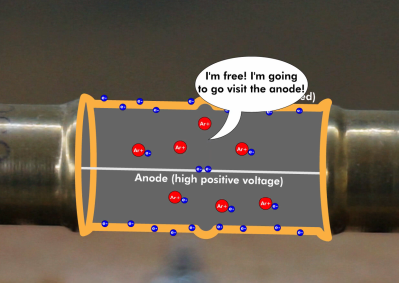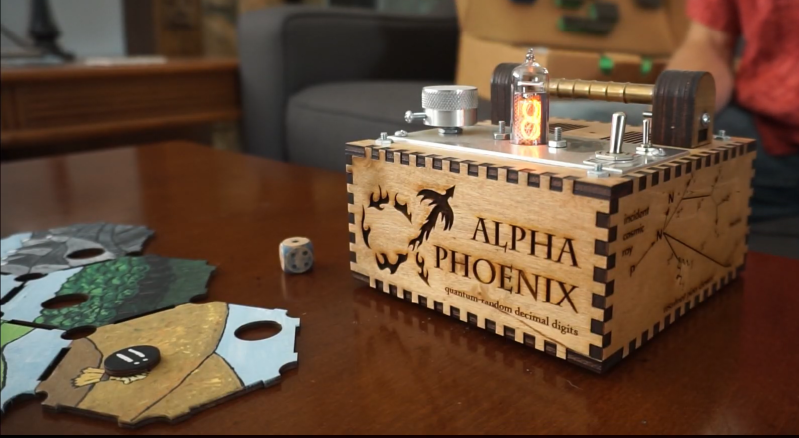Need a random number? Sure, you could just roll a die, but if you do, you might invite laughter from nearby quantum enthusiasts. If it’s truly, unpredictably random numbers you need, look no farther than the background radiation constantly bombarding us from the safety of its celestial hideout.
 In a rare but much appreciated break from the Nixie tube norm of clock making, [Alpha-Phoenix] has designed a muon-powered random number generator around that warm, vintage glow. Muons are subatomic particles that are like electrons, but much heavier, and are created when pions enter the atmosphere and undergo radioactive decay. The Geiger-Müller tube, mainstay of Geiger counters the world over, detects these incoming muons and uses them to generate the number.
In a rare but much appreciated break from the Nixie tube norm of clock making, [Alpha-Phoenix] has designed a muon-powered random number generator around that warm, vintage glow. Muons are subatomic particles that are like electrons, but much heavier, and are created when pions enter the atmosphere and undergo radioactive decay. The Geiger-Müller tube, mainstay of Geiger counters the world over, detects these incoming muons and uses them to generate the number.
Inside the box, a 555 in astable mode drives a decade counter, which outputs the numbers 0-9 sequentially on the Nixie via beefy transistors. While the G-M tube waits for muons, the numbers just cycle through repeatedly, looking pretty. When a muon hits the tube, a second 555 tells the decade counter to stop immediately. Bingo, you have your random number! The only trouble we can see with this method is that if you need a number right away, you might have to go get a banana and wave it near the G-M tube.
Whether this all makes sense or not, you should check out [Alpha-Phoenix]’s project video, which is as entertaining as it is informative. He’s planning a follow-up video focused on the randomness of the G-M tube, so look out for that.
Looking for a cheaper way to catch your random numbers? You can do it with a fish tank, some air pumps, and a sprinkle of OpenCV.
Via r/electronics
















7..7..7..7..7.. Oh that happens when the activity of a solar storm approximates a harmonic of the 555’s frequency. But who’s to say that a string of 7s isn’t random? In fact it *must* occur in a properly random sequence! 7..7..7..7..
Its not just muons, it just uses background. Could be from radon daughters, natural uranium and thorium, or the nixie tube itself might have a little bit of a radioisotope in it to make lower the ionization thresh hold. Yes, muons are part of that whole crew, but there is a hell of a lot more to background radiation than just muons. If you wanted to just use cosmic rays, a second tube would be required, preferably at some distance away (meters) and they would need a coincidence circuit. Two pulses at the same time have a high likelihood of being a cosmic ray shower. Yes, its a true random number generator, but a true muon detector it is not, as it can’t discriminate.
Correct. Muons might be detected, but to actually tell it’s a muon you kinda need fast scintillators and pulse shape analysis. And gating and other things. Most of the radiation he’s detecting is just background. I’m not sure, but I don’t even think that a geiger tube can actually detect muons.
yeah you guys are right. its a mix of muons and other things. i think i have seen a muon counter on youtube using sbm 20s stacked on top of each other so that a pulse in both indicated a vertically-traveling particle. muon arrival from the upper atmosphere is so difficult they basically must arrive vertically if they arrive at all. thats something i cheated on in the diagram a little bit.
“Vertically” as seen from the perspective of a human observer in the room with the detector? That restriction makes no sense at all. Assuming a spherical Earth and a spherical atmosphere why couldn’t muons travel from left to right with respect to the human observer, or anywhere in between?
The upper atmosphere isn’t just above my head, it’s all around me.
It won’t detect all of them, but the detections it makes are highly likely of pion origin. We did this experiment with a detector on the top and bottom floor of a multistory building once upon a time.
I’m specifically asking about muons so talking about pions doesn’t help me.
Here’s a followup question: How does one muon trigger two detector tubes? Ideally this would start with how one muon triggers one detector tube.
Just skimming though the video, but it looks like he only has one GM tube. Since there’s only one tube and no directional shielding, it’s impossible to tell if the radiation which set off the GM tube was terrestrial or celestial in origin.
Usually if you want to detect radiation from space you would have a vertical array of GM tubes, the idea being that if all the tubes are set off, then you know the radiation came from directly above or below, and below can be shielded with a chunk of lead. If only one or two tubes get set off, then the radiation came from the side and is likely terrestrial in origin.
yeah i assume (i think i read somewhere) about half of background radiation is terrestrial
Lo Salt (reduced sodium salt) is more radioactive than a banana (contains more potassium than a typical large banana, which would have less than half a gram along with a lot of shielding), it is about ten times background for most detectors in most locations on earth. And to be fair that Geiger-Müller tube is probably being triggered far more by gamma rays from the natural potassium level within Brian Haidet’s body, than by muons.
so if it gets stuck on a number, the Hulk is nearby?
The muon flux rate at the Earth’s surface is about 1 muon per square centimeter per minute. I’m guessing that tube is about 3/4cm by 5cm, so about 4 cm^2 cross section. So I’d expect maybe 4 muons per minute. Background on something like that is probably…30 counts per minute? So close enough to 10% from muons. The rest from terrestrial radioactivity. No matter in this application, though — they’re all random.
it’s correct that less than half of the counts will come from actual muons. the other half is due to electrons from beta decays and gamma photons. those stem rarely from potassium in humans or food since it‘s of low concentration and we’ll shielded and absorbed by surrounding matter (human flesh; whatever else makes up a banana)
The main source of beta & gamma radiation on earth is Radon decaying everywhere since it‘s a radioactive gas diffusing out of the ground all the time. One can cancel that part out if the detector is taken onto a deep lake or ocean. Then it‘d be mostly muons and the radiation from already decayed muons making a signal. Alternatively one can use two geiger tubes next to each other in coincidence mode (logic AND configuration) that‘d would be mostly triggered by muons only. This is how natural radioactivity was studied and discovered more than 100 years ago ;-)
hum, wonder if more true randomness comes from the incorporation of two 555 timers than the geiger tube.
/s
seriously, wonderful project and a great look. and random number generators have a certain bandwidth, that’s life.
and this one really puts you in touch with the universe.
slick.
how can it be random? It will show a number digit between 0 and 9, most numbers are longer than one digit in length. Also, the many worlds theory is either unlikely, or we will never be able to access, because if we could, someone would have done a rick and morty and crossed realities, the moment that happens, reality itself would break down due to the uncountable number of breaks across the multiverse.
Probably. but that’s the problem, isn’t it?
You can still combine as many digits as you want to a longer number.
“randomly selected” and “evenly distributed” are two different things. this device is absolutely random, but if i turn down the clock speed it gets less evenly distributed. and as for long decimals, this is a pick one of ten the way a coin flip is a pick one of two.
and yeah multiverse theory freaks me out – crossing seems impossible for the reason you stated
How 0-9 is random? A fair coin have 2 digits, and it’s random.
You can count to 9 digits, at 1GHz, and stop the counter every time you get a read from the tube.
could make an array of these and use them like the lava lamp wall for encryption
Yes, nuclear decay is random – for proper CSPRNG there is more work to be done but as soon as you have some source of “true randomness”, it is going to work.
Crazy multi-versers. It’s not plausible that I create 100 duplicate universes whenever I visit an ice-cream shop being indifferent on what flavor I’m going to buy and end up with a univers for each flavor I could potentially choose, 1,2,or 3 scoops, pointy cone or regular. …flat earthers make more sense.